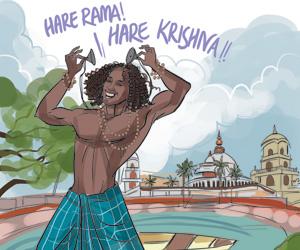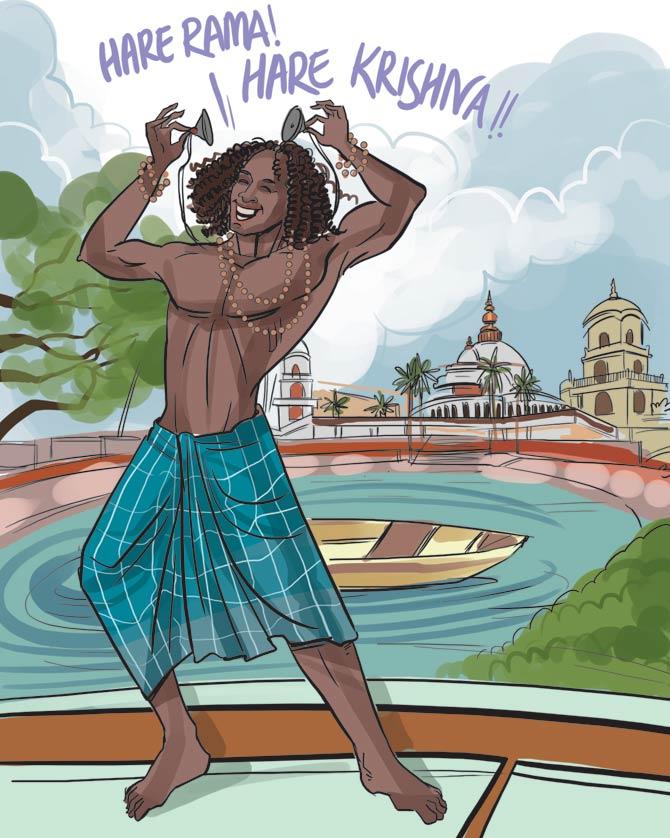We had been quietly floating down the Ganga, watching fishermen on modest noukas, families bathing at the ghats, harvested jute stacks, and schoolgirls waving from the banks, when a series of spectacular domes atop gigantic buildings swung into view


Illustration/Uday Mohite
 We had been quietly floating down the Ganga, watching fishermen on modest noukas, families bathing at the ghats, harvested jute stacks, and schoolgirls waving from the banks, when a series of spectacular domes atop gigantic buildings swung into view. Not only did they arrogantly dominate the skyline for miles, they were copies of the architecture of the Duomo Cathedral in Florence, Italy. Now what was such a building with European Christian architecture doing in a Hindu temple, in the otherwise modest town of Mayapur in Nadia district in West Bengal? It was the headquarters of the International Society for Krishna Consciousness (ISKCON). We might associate Lord Krishna with Vrindavan, Mathura and gopis, but it turns out Krishna has a secret taste for Italian architecture which you wouldn't have suspected. The famous Govinda's restaurant served pizzas and Subhadra's Kitchen specialised in Belgian waffles. As PG Wodehouse would say, I inspected the mind. It boggled. Inside the compound, there was an enormous mela, with phuchka (panipuri) stalls, and shops for toys, rosaries, liver tonics and more. Finally, in a series of enormous temples were statues of Krishna, the gopis, and of Srila Prabhupada. In fact, I had been invited to join my sister Sarayu and her friends on a week-long cruise, called the Bengal Saga, along the Ganga. We took the ship from Azimganj, about 217 km north of Kolkata, stopping off to explore historic towns along the river, including Murshidabad, Matiari, Mayapur, Kalna, the Portuguese port of Bandel and the former French colony Chandannagore, before reaching Kolkata.
We had been quietly floating down the Ganga, watching fishermen on modest noukas, families bathing at the ghats, harvested jute stacks, and schoolgirls waving from the banks, when a series of spectacular domes atop gigantic buildings swung into view. Not only did they arrogantly dominate the skyline for miles, they were copies of the architecture of the Duomo Cathedral in Florence, Italy. Now what was such a building with European Christian architecture doing in a Hindu temple, in the otherwise modest town of Mayapur in Nadia district in West Bengal? It was the headquarters of the International Society for Krishna Consciousness (ISKCON). We might associate Lord Krishna with Vrindavan, Mathura and gopis, but it turns out Krishna has a secret taste for Italian architecture which you wouldn't have suspected. The famous Govinda's restaurant served pizzas and Subhadra's Kitchen specialised in Belgian waffles. As PG Wodehouse would say, I inspected the mind. It boggled. Inside the compound, there was an enormous mela, with phuchka (panipuri) stalls, and shops for toys, rosaries, liver tonics and more. Finally, in a series of enormous temples were statues of Krishna, the gopis, and of Srila Prabhupada. In fact, I had been invited to join my sister Sarayu and her friends on a week-long cruise, called the Bengal Saga, along the Ganga. We took the ship from Azimganj, about 217 km north of Kolkata, stopping off to explore historic towns along the river, including Murshidabad, Matiari, Mayapur, Kalna, the Portuguese port of Bandel and the former French colony Chandannagore, before reaching Kolkata.
ADVERTISEMENT
What was astonishing at ISKCON was how multicultural the crowd was — Russians, Poles, Japanese and all. A group of Hare Krishna devotees was singing Hare Rama Hare Krishna in an open square, but it was the coolest reggae-ish rhythm of the bhajan I'd heard. The singer was a tall, black African in a lungi, singing and dancing with his arms raised above. Wonders never cease. Our guide said ISKCON had 600 centres worldwide. Here, it includes a gurukul for Vedic studies, a Mayapur Academy "to create qualified brahmanas for education, samskaras, deity worship," etc. Our guide added that Alfred Ford of Ford Motors was a big devotee-cum-donor and gave substantial funds for the building. There was a young, blond, blue-eyed boy, bald but for a choti, who played with his mobile phone while swimming in the Ganga. At Ambika Kalna, Maharajah Teja Chandra Bahadur of Bardhaman had built 108 magnificent Shiva temples with arched roofs and intricate terracotta ornamentation in 1809 AD: the jaw-dropping temples symbolically represent a double rosary. We crossed the street and saw the Pratapeshwar temple with even more intricate, world-class terracotta architecture. There was a grand rasmanch podium for theatre and music open to the skies.
We were having so much fun. "It is so boring travelling with husbands," one commented and a few of the others chorused in agreement. The cruise included fabulous curated places to see, wonderful cuisine aboard the ship, and superb live performances by local groups on the ship every evening, including a baul performance, Kathak by a transgender and her troupe, and Gaudiya Nritya. As the bauls sang, "Shader lau banailo more boiragi," I remembered the song from Runa Laila's version on Doordarshan decades ago, and only now realised what it meant: The dear gourd has made me a bairagi. There was even a yoga teacher on board, teaching yoga every morning, and a treadmill on the deck to exercise as the river swished past.
Our misty cabin windows wept in the mornings. As we woke up, we saw swathes of kaash flowers by the riverbanks. There were small whirlpools on the river. India bathes in the afternoons in its rivers, as the water is warmer then. Entire families bathe together.
Sukanta Das, who headed operations, explained to me about the river's eroding bank and distributing bank: the eroding bank had a sharper drop, while the distributing bank builds up silt. Moreover, I realised that from the middle of the river, it was impossible to tell, as the river rushed past, that we were in fact, static, as the ship had dropped anchor: you could only tell by looking at a point on the banks, whether you were static or going forward. There may be a moral there, struggling to get out.
Meenakshi Shedde is South Asia Consultant to the Berlin Film Festival, award-winning critic, curator to festivals worldwide and journalist. Reach her at meenakshishedde@gmail.com
 Subscribe today by clicking the link and stay updated with the latest news!" Click here!
Subscribe today by clicking the link and stay updated with the latest news!" Click here!







